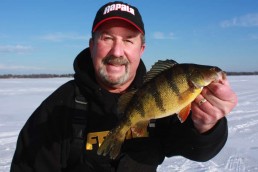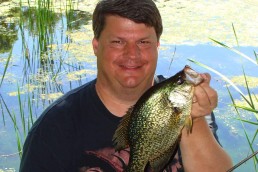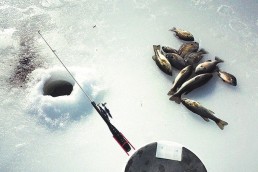The Late Ice-up, Green Weed Panfish Pattern
SHARE THIS POST
Here we are with another one of those late ice-ups that occur in the Upper Midwest every few years, where mild late-fall temps and continued above-average temps into early winter dominate. Ice-up may be late when compared to “average” years, but by no means is early ice in the first month of the year an unusual phenomenon.
When ice fishing season starts early, a predictable panfish pattern develops. An early sheet of ice across the shallow weed flats in natural lakes—especially when it’s combined with a November or December blanket of snow—always tends to push panfish deeper. Panfish always are drawn to weeds, whether they be the tops of emerging weed growth in spring, hidden in the vegetation in summer or staged on the deep weedlines by fall. The correlation between panfish location and weed growth is ongoing, but where you find the fish when you venture “iceward” can depend on a major variable: light penetration.
In mild winters, open water on larger lakes—or a minimum of ice on even small bodies of water—means good light penetration. More available light means increased levels of phytoplankton in the water column, increased oxygen content and greener weed beds overall. And although dying weed growth in winter (a process that’s accelerated by heavy ice and snow cover in an early freeze-up year) emits carbon dioxide that’s poisonous to the fish, green weeds produce healthy oxygen that holds panfish close. If limited snow cover allows for good light penetration for the entire winter season, you may find panfish holding close to weeds whenever you head out to ice fish.
Pay attention to weather history. Make note of snow and ice cover on your favorite lakes. Watch how this winter fishing season progresses. If conditions change (for example, a heavy blanket of snow and lots of cloudy days), don’t be discouraged when you return to a hot spot a week or two later to find your panfish have disappeared. Don’t assume that they aren’t biting today. More likely, your hot spot was within or adjacent to good green weed growth, and winter’s progression (and its effect on that weed growth) has driven your fish to deeper water. Continue to drill holes deeper and explore the mud basin pockets near the weedlines—you’ll likely reconnect with your early-ice pannies.
One of my favorite aspects of winter panfishing—especially for sunfish and bluegills—is they require less mobility to ensure success. While I’m all for punching dozens of holes on a hot Midwest walleye lake to stay in contact with loosely scattered walleye schools or roaming fish, a panfish outing is a relaxing endeavor by comparison. Light up the auger and drill along the weedline, with holes in both shallow (in dense vegetation) locations and areas strung along the deeper, more sparse edges.
Are you enjoying this post?
You can be among the first to get the latest info on where to go, what to use and how to use it!
Rig up a tiny Tungsten jig as a search lure. While these jigs excel at deep-water fishing because of their fast fall rate, they can be just as deadly as a search lure along shallow breaklines, allowing you to quickly drop down a hole to check for activity as you scout hole-to-hole. You don’t even need live bait—the incredible variety for excellent finesse soft plastics on the market mean you can tailor a presentation for maximum success. Your best bet: Experiment with colors and the actual profiles of different plastics to learn what trigger the most bites. Even panfish can be finicky, but when you find the hot ticket, you’ll have multiple sunnies in the school zeroing in on your lure on every drop.
Here’s another tidbit to add to the fun of the early-ice panfish bite when targeting fish in shallow weedlines: sight-fishing.
In a brutal winter year—when conditions drive panfish out of the shallows and into deep-water haunts—sight-fishing loses out to your “electronic eyes.” The only way you’ll see fish activity in relation to your jig in deep water is with a flasher or underwater camera. In a mild winter, however, when you find early-ice fish in the weeds, you can lay down right on the ice and throw your coat up over your head and watch fish activity below. Of course, if the lake you choose is deeply stained or turbid, you’ll be limited by those conditions. But one of the benefits of ice cover is no wind and wave action to stir up the lake. And, clear-water conditions make sight-fishing fun for kids of all ages. A variety of 15- to 18-inch ice rods on the market are ideally suited for this close-quarters jigging as described.
It’s peak early-ice season right now. Get out there as often as you can and enjoy some winter fun.
MWO
SHARE THIS POST
Did you enjoy this post?
You can be among the first to get the latest info on where to go, what to use and how to use it!



